Nineteen-Level Open Systems Interaction Model
Good reading time, dear participants habrahabr.ru
Not so long ago, I introduced a nine-level model for the interaction of open systems ( http://habrahabr.ru/post/176391/ ).
This approach did not receive unequivocal support, and therefore the model had to be further developed.
First, a quote, which, in my opinion, most fully reflects the direction of development.
Koplien J., Multiparadigm Design for C ++. Programmer's library. - St. Petersburg: Peter, 2005. P. 99,
So, I offer the readers a seventeen-level model, which I propose to use when reading textbooks of philosophy, psychology, sociology, economics with a secret idea to translate all this into programming languages :-).
The approach is based on the philosophical idea of dualism, and begins with the introduction of two initial elements:
- ideas - as an abstraction that is self-sufficient for its definition
- emptiness - as material, for which no idea is needed
The remaining elements are squeezed between these elements, symmetrically moving them apart from each other as complexity develops. Qualitative levels of development of complexity are presented in the diagrams below. The basic assumption is the symmetry of the abstract and the material - for material concepts, there are symmetrical abstract ones. An additional assumption is a symmetrical disclosure of nature and concepts from the edges to the center.
For example, the extreme elements correspond to the most material (emptiness, for which additional characteristics are impossible) and the most abstract (idea, for which there is no material representation). This approach corresponds to the equal importance of the material and the ideal in the development of nature (dualism).
For all levels in the proposed model remains selection
of four elements of the PDCA Deming cycle: -Act-Plan-Do-Check-Act-
I note that the coordinate system of Hans Jürgen Eisenck from three orthogonal axes
is chosen as the basis: - Psychotism - level of abstractness
- Neurotism and Extroversion - as a direction to the element of the Deming cycle in polar coordinates
Naturally, as an initial assumption, schemes do not claim to be true. Everyone can create, using a spherical paradigm, their options, which will be based on their categories, levels, phases.
So, I present the model - so far in the form of graphic elements for modeling. At the heart of the left field of the images was a set of symbols symmetrical with respect to reality.
The general scheme: a
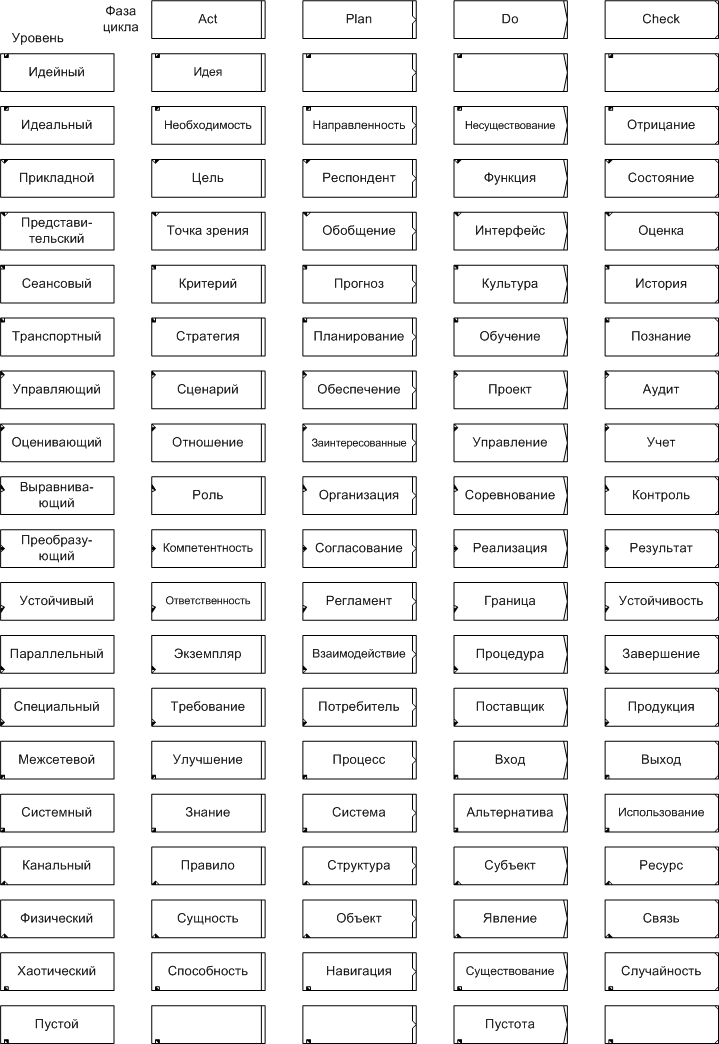
variant of the ordering of sciences by levels of abstractness:
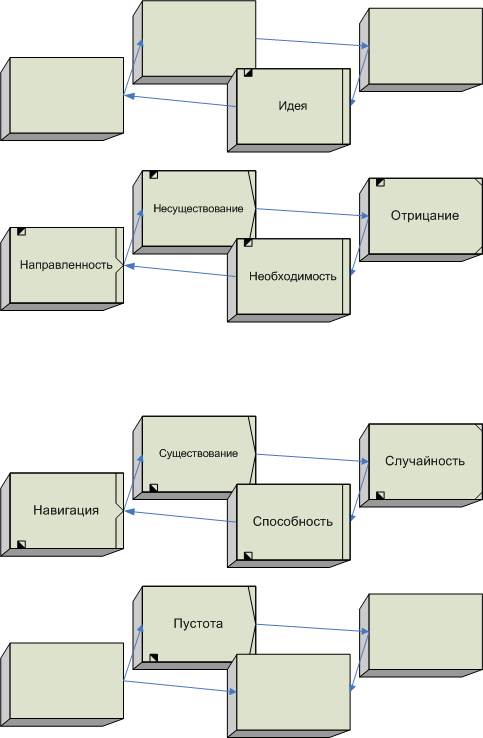
As the most abstract concept, the idea stands out (Plato, Hume, Hegel).
The most appropriate idea is denial , as an operation not applicable to more real elements. In this regard, denial is often used to verify correctness. In mathematics, this is called "proof by contradiction."
The basis of the idea of something is not the existence of the idea itself . In addition, the idea of something is characterized by the purpose of the idea (indicated as orientation ).
In the value-normative component, the idea is characterizednecessity : any phenomenon can be expressed by its idea .
The least abstract, and the most material (not bearing any idea ) is represented by the concept of emptiness (in C it is described by the void type ).
Moreover, even emptiness can be expressed using the idea of emptiness .
Following the empty level, with increasing abstractness, is the level of chaos.
The properties of matter at this level can only be described statistically. However, these statistics make it possible to evaluate field properties ( ability) and determine the spatio-temporal characteristics for conglomerates - tel. The main property of chaos is the existence of its elements. At the same time, it is not possible to identify specific elements of the element trajectories ( randomness ).
A random level is the most fundamental. For example, it is difficult to predict the appearance of comets from deep space, and Siberia, as the largest part of the land, is the most likely territory for meteor showers.
In cybernetics, self-testing when the processor is turned on is used to protect against the influence of accidents, as well as protection from a fool - an attempt to envisage a reaction to all possible user actions - logical (coinciding with the purpose of the system) and not logical (falling of a hedgehog on the keyboard)

For the ideal, the following segments are further distinguished:
Purpose - as an attempt to determine the reason for the formation of a specific idea.
Source of external justification of the goal ( respondent ).
Possibilities of using ideas - function.
Way of fixing the achievement of the goal - state.
In the material plane, they correspond to the behavior of matter investigated by physics - the interaction of two bodies the interaction of the body and the field: the
first step is to determine the type of interaction - the entity
is allocated a space-time region, the behavior of which is estimated and forecast being zoned ( object )
for a selected object , its state ( phenomenon ) is fixed in a certain coordinate system;
the environmental effect on the object is
determined. At the same time, for a certain study: the
essence is fixed as the goal of existence, the goal
source justifying the consideration is the object , the object’s phenomenon is assumed as its main function, possible states the objects are supposed to be mediated by its connections with the environment
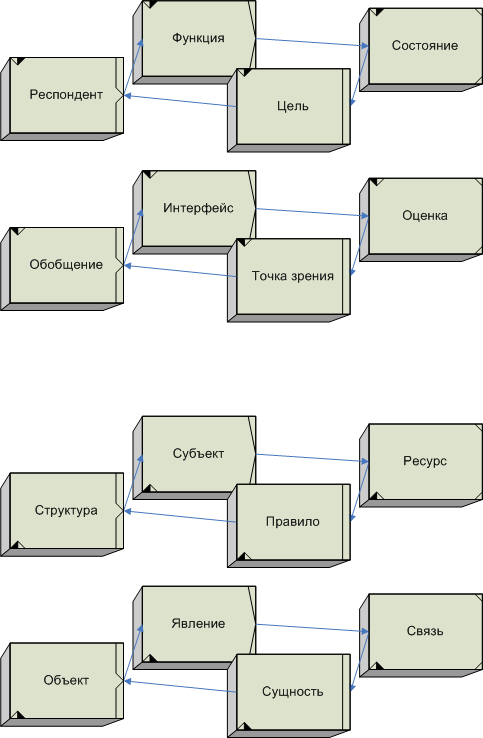
When extending the researchers to the categories of existence and purpose are added to the description by the structure of the studied concepts
in the area of the ideal:
Adds the point of view , as a characteristic, unifying view of the world, which represents the pursuit of goals
is allocated a generalization , as a method of compression of several ideas into one under consideration in certain section (for interaction with a particular type of respondents - actually an abstraction )
Under this interface, in this context, is understood a designated set of ideas transmitted and received signalscharacterizing the designated function
Assessment is defined as some procedure that facilitates obtaining information about the state of the external respondent.
Historically, this part is close to the work of shamans broadcasting about the “will of the gods.”
In the material field, structural division appears that corresponds to revealing the structure of a substance (chemistry), information and the basis for the operations of logic and arithmetic, which are determined by a variety of authorized rules
revealed in the prior entity determines the applicability of the sets of rules
were isolated enny objectit is analyzed for the possibility of determining its internal structure ( structure ).
The phenomenon gives rise to the subject that it changes , like a sensor-receptor aimed at recording precisely this kind of phenomena.
The accumulation of previous changes in the subject characterizes the resource , the “caretaker” of which is considered to be the subject . The basis of the resource is the connection between the phenomenon and the subject. The
relationship between the ideal and the material for this pair of levels is determined by the following characteristics:
The point of view determines the set of rules used(is it possible to stack red apples with greens?) The
possibility of determining the structure is governed by the possibility of generalization (is it possible to combine hydrogen atoms with one concept when considering the properties of a water molecule)
The subject is characterized by the interface used (scales do not determine the dimensions or color of an object)
The accumulation of a certain resource requires the possibility of its assessment (for example, “not a single one” already requires setting the structure within which the assessment is made , the states “not enough”, “enough”, “too much”, etc. .P.)
Within these levels, the rules of logic and arithmetic are introduced
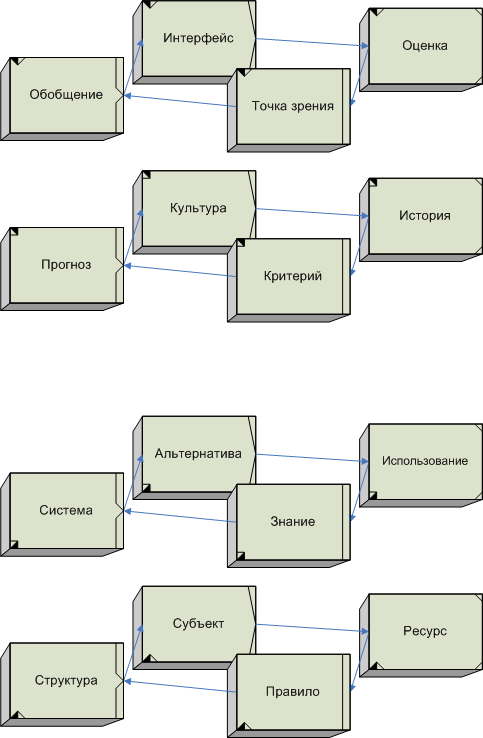
With further development becomes possible to use resources to maintain self
In the ideal it becomes possible to predict future states based cognized rules and selected viewpoint
Brief characteristic dynamic assessment situations are criteria
for possible future existence without deteriorating condition used forecast changes in possible embodiments change system and environmental Environment
A set of preferred actions determines culture .
An ideal analogue of a resource appears - history , as the totality of the consequences of applying the rules together with the conditions for their application and results.
In the material field, the evolution of systems that provide their own homeostasis within an individual or species takes place . This corresponds to the development of living beings and similar artificial formations.
Knowledge is a set of rules with the context of their application in the presence of various methods of their own change.
The system in this case is understood in accordance with the following definition: system - structurecapable of maintaining homeostasis.
For existence, a system can have a choice of several alternatives - methods of using resources.
After using, to implement one of the alternative possibilities, available resources are quantified.
The relationship between the ideal and the material: The
knowledge accumulated by the system allows you to choose criteria that contribute to maintaining the system.
Maintaining homeostasis itself requires the ability to compare projections of actions against the selected criteria of
Knowledgeallow you to review several alternative actions ( choice ), while a set of priority alternatives ( culture ) appears. In the course of the
action, the accumulated resources are used . Evolution allows you to accumulate a history of situations, applied rules , and selected alternatives . This approach creates the prerequisites for the development of science on the scale of a single cultural phenomenon - civilization

After the appearance of systems sufficient to independent existence with the resources of the environment, and the ability to remember previous changes in the abstract there is the possibility of accumulation of behavioral stereotypes, and, accordingly, the possibility of learning .
In the field of the ideal, the possibility arises of cognition based on accumulated history and planning behavior in accordance with the assessment of the criteria .
For a successful existence from a variety of different types of behavior, a strategy is used . For example, eat grass and be afraid, or be a predator, and catch.
After choosing a strategy , it becomes possible to plan your behavior. For example, the cheetah is trying to catch prey, and the wolves organize hunting in a group.
In the process of achieving (or not achieving) the goal , training takes place - endurance training or an increase in quantity.
The result of the training is cognition , which contributes to the selection of criteria and improvement of the strategy .
In the field of material psychological processes appear that are described in the framework of the process approach.
In order to win in natural selection, the natural requirement is to improve the performance of the system .
To implement the behavior, it is possible to use various processes that represent methods of converting input to output . In accordance with the successful SADT methodology (IDEF0), the mandatory input type is the manager - which starts the process .
The process input must receive the necessary resources for use , which the system must take care of . If the required input is not filled, the processmay stop. Sometimes such a cessation of the process leads to disaster (lack of air at the diver or lack of regulation at the Chernobyl nuclear power plant).
The results of the process are "caught" at the output . If the output does not meet expectations, then this is an occasion for improvement .
The relationship between the ideal and the material:
To improve the functioning of the system , a strategy is applied.
When choosing a process , planning is applied.
The supply of control signals to the input of the system promotes learningpossible behaviors.
Cognition tracks the system’s output to expectations.
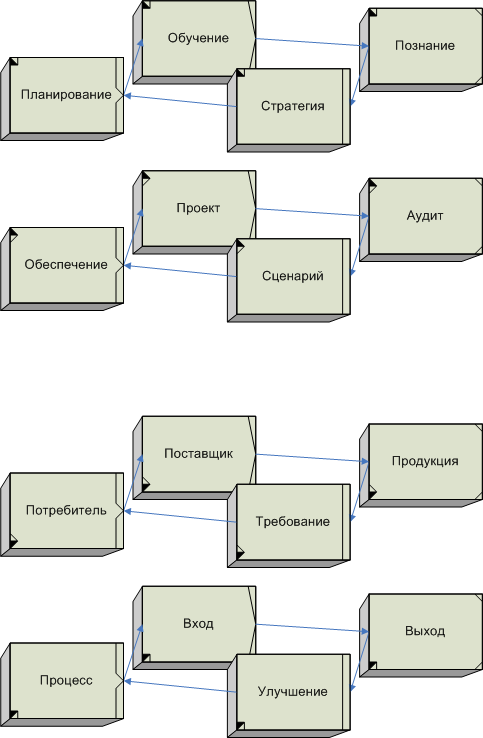
The result of training in the presence of different systems (and nature does not tolerate not only emptiness, but also the same) is the ability to compare the predisposition to fulfill the necessary or possible roles.
In the ideal field, the possibility of cybernetic control appears .
the implementation of the developed strategy is facilitated by the choice of a scenario that will lead to an improvement in the value of the selected criterion;
planning includes the need to ensure the execution of the scenario in specific conditions by transmitting a sequence of signals and material flows
training in the execution of the scenario is formulated in the form of a project - an ideal model of the actions to be performed
after the implementation of the project , an audit is carried out - cognition of the correspondence of the built-up technological chain of the chosen strategy.
In the material field, social relationships based on using differences between material objects appear.
requirements contribute to the formulation of the desire to improve the subsystem in material form, the
consumer acts as the initiator of the launch of well - known processes
supplierperforms supply problem in the input process the necessary control signals and resources obtained at the output of other processes
important output of the main executable process is a product that can be evaluated for compliance with the requirements of the
connection between the ideal and the material:
the requirements to fulfill the role in society accompanied by the possible scenarios that lead to a successful the fulfillment of this role, the
fulfillment of a social role is performed to achieve satisfactionthe consumer of this service, customer satisfaction is the formation of the need to provide the necessary results from other members of society
to meet the needs of the consumer, the member of the society acts as a provider of this service / product , while the product itself at this stage acts as a project, the
result of the project is the product , which is evaluated by the consumer through audit - a comparison of the project and the productby significant criteria

The next stage in the development of social is the emergence of interchangeability (the development of the army with the emergence of types of troops, the opening of collective training, the emergence of workshops in medieval Europe, the emergence of merchants, the emergence of the proletariat)
In the ideal area, the possibility of exchanging labor products and the emergence of trade with the allocation of a universal commodity equivalent - money.
corresponds to the presence of subliminal relationship between the social groups
labor separation facilitates searching interested in applying their activities and providing life support
interaction interested groups requires the current controlTo comply with the developed projects
, equity considerations require accounting , which serves to assess the correctness of relations.
In the material sphere, economic relations appear based on the ability to manage organizational structures .
the basis of relations is an organizational instance that is able to fulfill social requirements;
the interaction proposal is a contract, on the basis of which the participants assume the future
elements of the contract are a set of proceduresthat allow to evaluate the correctness of the actions performed , the
need for the completion stage is dictated by the variability of relations , this is especially manifested in the change in the brands of mobile phones :-) The
relationship between the ideal and the material: the
relationship between the elements to simplify the interaction at this level requires a single instance representing the
interaction of social groups groups requires mutual interest groups in each other
management interaction occurs via agreed procedures
Uch in a continuous process, it leads to the need to designate completion points at which a virtually continuous process is evaluated (fiscal year, session, election)
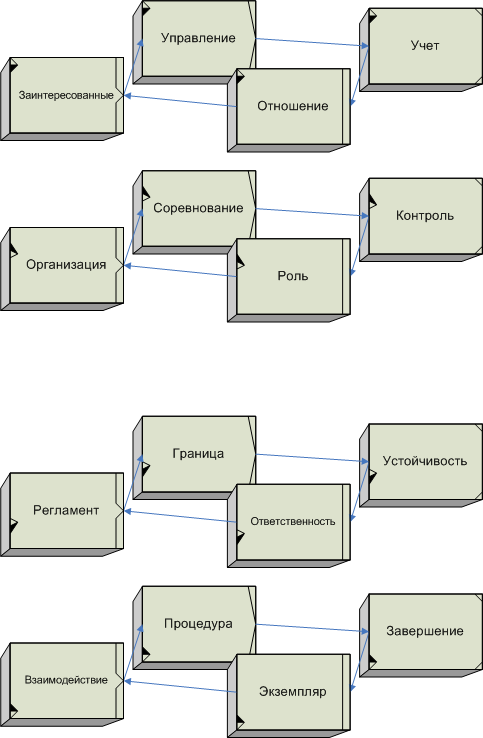
The next step is the development of competition , based on the rules of the same initial conditions, and due to this expansion possible hierarchical ways of management for all civilization, the development of previously inaccessible areas (space, ocean) and the understanding of the inclusion of mankind in the global processes of the Earth, the solar system, the universe
is aware of area of responsibility, contributing to the development of the noosphere
in the ideal:
a lot of situations that arise in society raises many essential roles
for the purpose and Fillers on the role serves as the organization
can choose from dozens of applicants contribute to the developmentcompetition in capitalist society, such competition is based on Adam Smith’s free competition, in classless competition of V.I. Ulyanov, in sports - championships and the Olympic Games
to monitor the correctness of the performance of the role , control is exercised
In the field of material:
for self-limitation of the impact of potentially infinite expansion of resource consumption there is a responsibility for the use of the technical and institutional capacity
is developed regulation of activities, cn Property Management responsibility
appointed borderthe applicability of the regulation in time and space, the
main control parameter is the stability of the existence of a certain region of space / time.
The opening of this level corresponds to the publications of K.E. Tsiolkovsky, as well as to science fiction writers of the 20th century.
The connection between the material and the ideal:
the role allocated to assign responsibility for any area of
regulation contributes to the organization of society
competition between organizational elements requires the appointment of boundaries between these elements (eg, antitrust)
resistancepart of the space regarding regulations and organizations requires the presence of control over the effect of action / inaction from these organizations
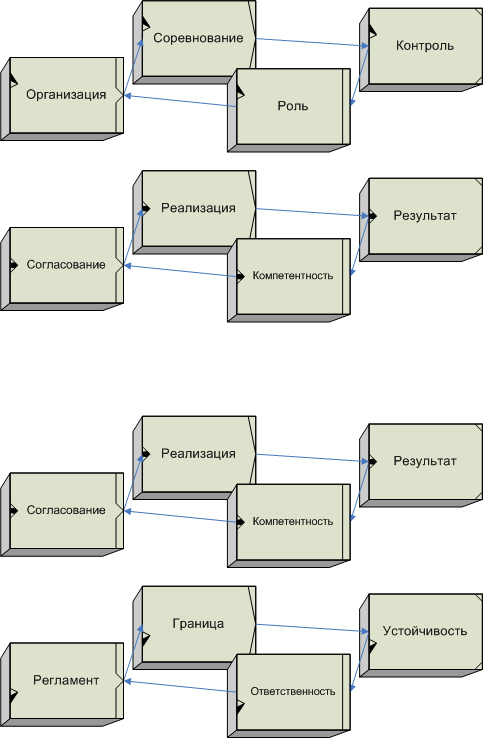
assessment of compliance with the responsibility to fulfill the role is the competence (applied education, certification, certification, licensing, etc.)
to comply with decisions of the organization regulations provide a mechanism matching
the implementation is carried out in certain boundaries , thus made transparent (competition, money) or transparent ( fame, image, awards) competition the
result is the need of the competitive mechanism, while a stable (linear) change in the result is a sign of sustainability, and to monitor the equitable use of resources , independent control is carried out.
I hope this set of elements is enough to simulate most applications.
I would be grateful for a reason to change my mind in the form of criticism and wishes.
Upd: 03.03.2014 - a description text has been added from integral-community.ru/forum/viewtopic.php?f=12&t=167
Upd: 04/30/2014 - new version of the

Upd scheme : Previous version from 07/15/2014:

Upd: 07/26/2014 - the number of levels is increased to 21, the Do phase is synchronized with EPC:
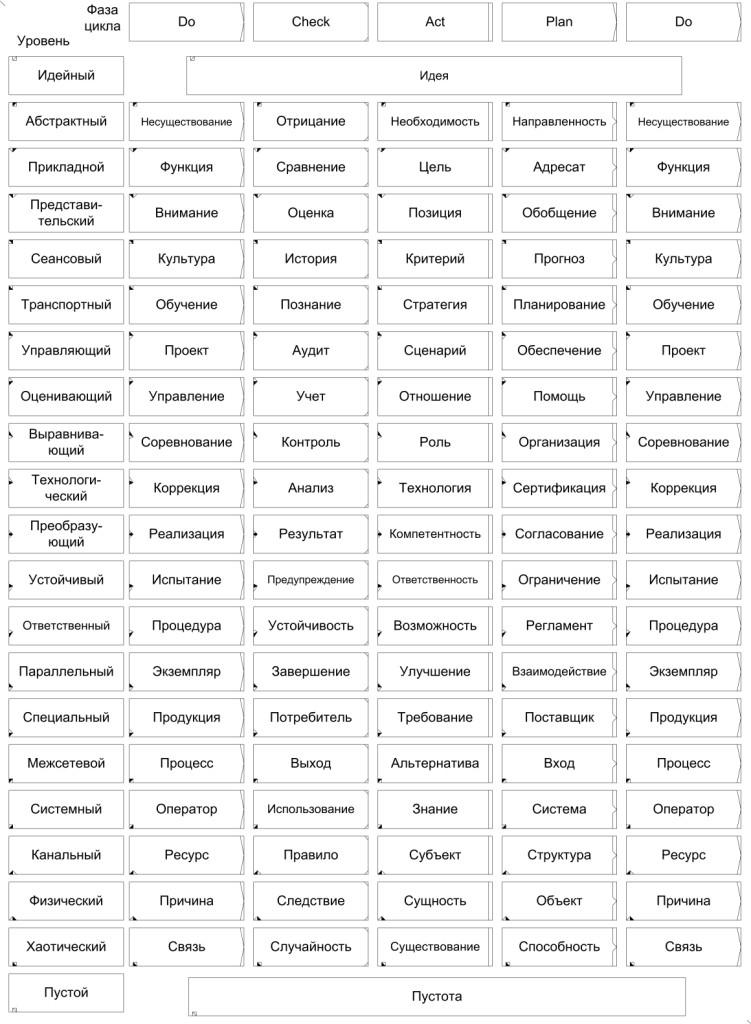
Comparison of EPC with tunnel modeling:
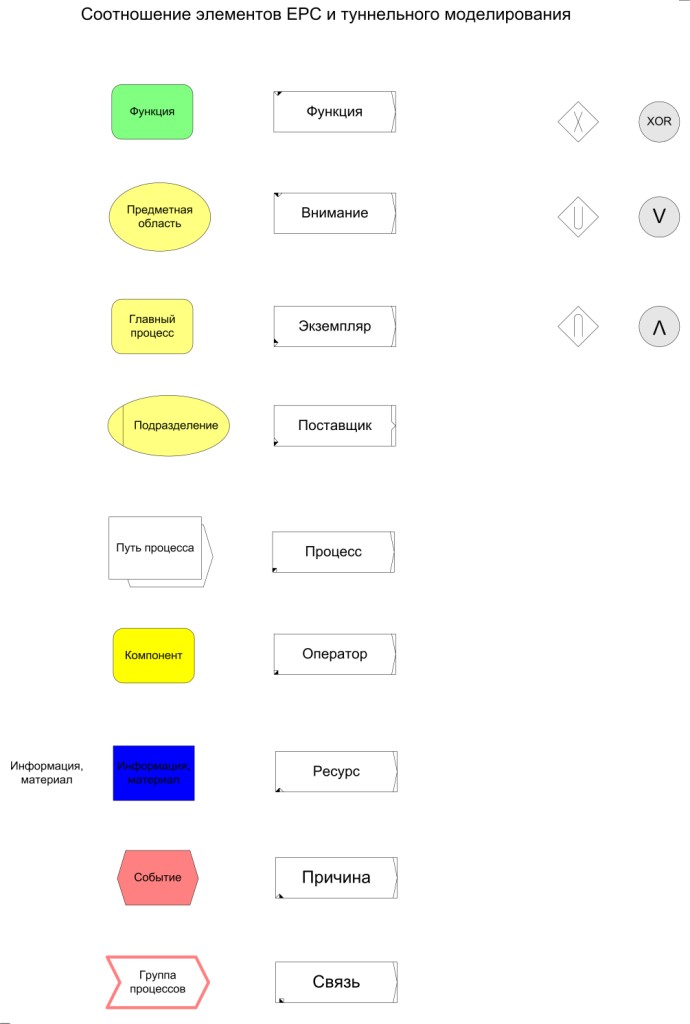
Not so long ago, I introduced a nine-level model for the interaction of open systems ( http://habrahabr.ru/post/176391/ ).
This approach did not receive unequivocal support, and therefore the model had to be further developed.
First, a quote, which, in my opinion, most fully reflects the direction of development.
Koplien J., Multiparadigm Design for C ++. Programmer's library. - St. Petersburg: Peter, 2005. P. 99,
5.1 About paradigms and objects
The term “paradigm”, which became known from the book by Kahn [Kuhn, 1970], entered the everyday life of software in connection with the popularization of the object paradigm. A paradigm is a set of agreements within which we represent the world around us. In software, paradigms determine how we formulate abstractions. What is your world made of? Do you divide the world into procedures? Data records? Modules? Or classes and objects?
In practice, the paradigm defines the rules, means and agreements for dividing the world into separate understandable parts. Paradigm goals typically include a quality characterization, roughly called modularity, which means that analysis should create coherent abstractions with minimal linkage. If the abstractions are independent, then their owners can develop them separately, without interfering with each other. If we assume that the system can be developed in parts, then the paradigms help us create islands of change.
So, I offer the readers a seventeen-level model, which I propose to use when reading textbooks of philosophy, psychology, sociology, economics with a secret idea to translate all this into programming languages :-).
The approach is based on the philosophical idea of dualism, and begins with the introduction of two initial elements:
- ideas - as an abstraction that is self-sufficient for its definition
- emptiness - as material, for which no idea is needed
The remaining elements are squeezed between these elements, symmetrically moving them apart from each other as complexity develops. Qualitative levels of development of complexity are presented in the diagrams below. The basic assumption is the symmetry of the abstract and the material - for material concepts, there are symmetrical abstract ones. An additional assumption is a symmetrical disclosure of nature and concepts from the edges to the center.
For example, the extreme elements correspond to the most material (emptiness, for which additional characteristics are impossible) and the most abstract (idea, for which there is no material representation). This approach corresponds to the equal importance of the material and the ideal in the development of nature (dualism).
For all levels in the proposed model remains selection
of four elements of the PDCA Deming cycle: -Act-Plan-Do-Check-Act-
I note that the coordinate system of Hans Jürgen Eisenck from three orthogonal axes
is chosen as the basis: - Psychotism - level of abstractness
- Neurotism and Extroversion - as a direction to the element of the Deming cycle in polar coordinates
Naturally, as an initial assumption, schemes do not claim to be true. Everyone can create, using a spherical paradigm, their options, which will be based on their categories, levels, phases.
So, I present the model - so far in the form of graphic elements for modeling. At the heart of the left field of the images was a set of symbols symmetrical with respect to reality.
The general scheme: a

variant of the ordering of sciences by levels of abstractness:
logical
religious
philosophical
cultural
political
management
marketing
sports
technological
transformative
sustainable
synergistic
economic
social
psychological
biological
chemical
physical
astrophysical
Ideal and material

As the most abstract concept, the idea stands out (Plato, Hume, Hegel).
The most appropriate idea is denial , as an operation not applicable to more real elements. In this regard, denial is often used to verify correctness. In mathematics, this is called "proof by contradiction."
The basis of the idea of something is not the existence of the idea itself . In addition, the idea of something is characterized by the purpose of the idea (indicated as orientation ).
In the value-normative component, the idea is characterizednecessity : any phenomenon can be expressed by its idea .
The least abstract, and the most material (not bearing any idea ) is represented by the concept of emptiness (in C it is described by the void type ).
Moreover, even emptiness can be expressed using the idea of emptiness .
Following the empty level, with increasing abstractness, is the level of chaos.
The properties of matter at this level can only be described statistically. However, these statistics make it possible to evaluate field properties ( ability) and determine the spatio-temporal characteristics for conglomerates - tel. The main property of chaos is the existence of its elements. At the same time, it is not possible to identify specific elements of the element trajectories ( randomness ).
A random level is the most fundamental. For example, it is difficult to predict the appearance of comets from deep space, and Siberia, as the largest part of the land, is the most likely territory for meteor showers.
In cybernetics, self-testing when the processor is turned on is used to protect against the influence of accidents, as well as protection from a fool - an attempt to envisage a reaction to all possible user actions - logical (coinciding with the purpose of the system) and not logical (falling of a hedgehog on the keyboard)
Physical and Religious

For the ideal, the following segments are further distinguished:
Purpose - as an attempt to determine the reason for the formation of a specific idea.
Source of external justification of the goal ( respondent ).
Possibilities of using ideas - function.
Way of fixing the achievement of the goal - state.
In the material plane, they correspond to the behavior of matter investigated by physics - the interaction of two bodies the interaction of the body and the field: the
first step is to determine the type of interaction - the entity
is allocated a space-time region, the behavior of which is estimated and forecast being zoned ( object )
for a selected object , its state ( phenomenon ) is fixed in a certain coordinate system;
the environmental effect on the object is
determined. At the same time, for a certain study: the
essence is fixed as the goal of existence, the goal
source justifying the consideration is the object , the object’s phenomenon is assumed as its main function, possible states the objects are supposed to be mediated by its connections with the environment
Chemical and Philosophical

When extending the researchers to the categories of existence and purpose are added to the description by the structure of the studied concepts
in the area of the ideal:
Adds the point of view , as a characteristic, unifying view of the world, which represents the pursuit of goals
is allocated a generalization , as a method of compression of several ideas into one under consideration in certain section (for interaction with a particular type of respondents - actually an abstraction )
Under this interface, in this context, is understood a designated set of ideas transmitted and received signalscharacterizing the designated function
Assessment is defined as some procedure that facilitates obtaining information about the state of the external respondent.
Historically, this part is close to the work of shamans broadcasting about the “will of the gods.”
In the material field, structural division appears that corresponds to revealing the structure of a substance (chemistry), information and the basis for the operations of logic and arithmetic, which are determined by a variety of authorized rules
revealed in the prior entity determines the applicability of the sets of rules
were isolated enny objectit is analyzed for the possibility of determining its internal structure ( structure ).
The phenomenon gives rise to the subject that it changes , like a sensor-receptor aimed at recording precisely this kind of phenomena.
The accumulation of previous changes in the subject characterizes the resource , the “caretaker” of which is considered to be the subject . The basis of the resource is the connection between the phenomenon and the subject. The
relationship between the ideal and the material for this pair of levels is determined by the following characteristics:
The point of view determines the set of rules used(is it possible to stack red apples with greens?) The
possibility of determining the structure is governed by the possibility of generalization (is it possible to combine hydrogen atoms with one concept when considering the properties of a water molecule)
The subject is characterized by the interface used (scales do not determine the dimensions or color of an object)
The accumulation of a certain resource requires the possibility of its assessment (for example, “not a single one” already requires setting the structure within which the assessment is made , the states “not enough”, “enough”, “too much”, etc. .P.)
Within these levels, the rules of logic and arithmetic are introduced
Biological and Scientific

With further development becomes possible to use resources to maintain self
In the ideal it becomes possible to predict future states based cognized rules and selected viewpoint
Brief characteristic dynamic assessment situations are criteria
for possible future existence without deteriorating condition used forecast changes in possible embodiments change system and environmental Environment
A set of preferred actions determines culture .
An ideal analogue of a resource appears - history , as the totality of the consequences of applying the rules together with the conditions for their application and results.
In the material field, the evolution of systems that provide their own homeostasis within an individual or species takes place . This corresponds to the development of living beings and similar artificial formations.
Knowledge is a set of rules with the context of their application in the presence of various methods of their own change.
The system in this case is understood in accordance with the following definition: system - structurecapable of maintaining homeostasis.
For existence, a system can have a choice of several alternatives - methods of using resources.
After using, to implement one of the alternative possibilities, available resources are quantified.
The relationship between the ideal and the material: The
knowledge accumulated by the system allows you to choose criteria that contribute to maintaining the system.
Maintaining homeostasis itself requires the ability to compare projections of actions against the selected criteria of
Knowledgeallow you to review several alternative actions ( choice ), while a set of priority alternatives ( culture ) appears. In the course of the
action, the accumulated resources are used . Evolution allows you to accumulate a history of situations, applied rules , and selected alternatives . This approach creates the prerequisites for the development of science on the scale of a single cultural phenomenon - civilization
Psychological and Political

After the appearance of systems sufficient to independent existence with the resources of the environment, and the ability to remember previous changes in the abstract there is the possibility of accumulation of behavioral stereotypes, and, accordingly, the possibility of learning .
In the field of the ideal, the possibility arises of cognition based on accumulated history and planning behavior in accordance with the assessment of the criteria .
For a successful existence from a variety of different types of behavior, a strategy is used . For example, eat grass and be afraid, or be a predator, and catch.
After choosing a strategy , it becomes possible to plan your behavior. For example, the cheetah is trying to catch prey, and the wolves organize hunting in a group.
In the process of achieving (or not achieving) the goal , training takes place - endurance training or an increase in quantity.
The result of the training is cognition , which contributes to the selection of criteria and improvement of the strategy .
In the field of material psychological processes appear that are described in the framework of the process approach.
In order to win in natural selection, the natural requirement is to improve the performance of the system .
To implement the behavior, it is possible to use various processes that represent methods of converting input to output . In accordance with the successful SADT methodology (IDEF0), the mandatory input type is the manager - which starts the process .
The process input must receive the necessary resources for use , which the system must take care of . If the required input is not filled, the processmay stop. Sometimes such a cessation of the process leads to disaster (lack of air at the diver or lack of regulation at the Chernobyl nuclear power plant).
The results of the process are "caught" at the output . If the output does not meet expectations, then this is an occasion for improvement .
The relationship between the ideal and the material:
To improve the functioning of the system , a strategy is applied.
When choosing a process , planning is applied.
The supply of control signals to the input of the system promotes learningpossible behaviors.
Cognition tracks the system’s output to expectations.
Management and Social

The result of training in the presence of different systems (and nature does not tolerate not only emptiness, but also the same) is the ability to compare the predisposition to fulfill the necessary or possible roles.
In the ideal field, the possibility of cybernetic control appears .
the implementation of the developed strategy is facilitated by the choice of a scenario that will lead to an improvement in the value of the selected criterion;
planning includes the need to ensure the execution of the scenario in specific conditions by transmitting a sequence of signals and material flows
training in the execution of the scenario is formulated in the form of a project - an ideal model of the actions to be performed
after the implementation of the project , an audit is carried out - cognition of the correspondence of the built-up technological chain of the chosen strategy.
In the material field, social relationships based on using differences between material objects appear.
requirements contribute to the formulation of the desire to improve the subsystem in material form, the
consumer acts as the initiator of the launch of well - known processes
supplierperforms supply problem in the input process the necessary control signals and resources obtained at the output of other processes
important output of the main executable process is a product that can be evaluated for compliance with the requirements of the
connection between the ideal and the material:
the requirements to fulfill the role in society accompanied by the possible scenarios that lead to a successful the fulfillment of this role, the
fulfillment of a social role is performed to achieve satisfactionthe consumer of this service, customer satisfaction is the formation of the need to provide the necessary results from other members of society
to meet the needs of the consumer, the member of the society acts as a provider of this service / product , while the product itself at this stage acts as a project, the
result of the project is the product , which is evaluated by the consumer through audit - a comparison of the project and the productby significant criteria
Marketing and utilities

The next stage in the development of social is the emergence of interchangeability (the development of the army with the emergence of types of troops, the opening of collective training, the emergence of workshops in medieval Europe, the emergence of merchants, the emergence of the proletariat)
In the ideal area, the possibility of exchanging labor products and the emergence of trade with the allocation of a universal commodity equivalent - money.
corresponds to the presence of subliminal relationship between the social groups
labor separation facilitates searching interested in applying their activities and providing life support
interaction interested groups requires the current controlTo comply with the developed projects
, equity considerations require accounting , which serves to assess the correctness of relations.
In the material sphere, economic relations appear based on the ability to manage organizational structures .
the basis of relations is an organizational instance that is able to fulfill social requirements;
the interaction proposal is a contract, on the basis of which the participants assume the future
elements of the contract are a set of proceduresthat allow to evaluate the correctness of the actions performed , the
need for the completion stage is dictated by the variability of relations , this is especially manifested in the change in the brands of mobile phones :-) The
relationship between the ideal and the material: the
relationship between the elements to simplify the interaction at this level requires a single instance representing the
interaction of social groups groups requires mutual interest groups in each other
management interaction occurs via agreed procedures
Uch in a continuous process, it leads to the need to designate completion points at which a virtually continuous process is evaluated (fiscal year, session, election)
Competitive and Cosmic

The next step is the development of competition , based on the rules of the same initial conditions, and due to this expansion possible hierarchical ways of management for all civilization, the development of previously inaccessible areas (space, ocean) and the understanding of the inclusion of mankind in the global processes of the Earth, the solar system, the universe
is aware of area of responsibility, contributing to the development of the noosphere
in the ideal:
a lot of situations that arise in society raises many essential roles
for the purpose and Fillers on the role serves as the organization
can choose from dozens of applicants contribute to the developmentcompetition in capitalist society, such competition is based on Adam Smith’s free competition, in classless competition of V.I. Ulyanov, in sports - championships and the Olympic Games
to monitor the correctness of the performance of the role , control is exercised
In the field of material:
for self-limitation of the impact of potentially infinite expansion of resource consumption there is a responsibility for the use of the technical and institutional capacity
is developed regulation of activities, cn Property Management responsibility
appointed borderthe applicability of the regulation in time and space, the
main control parameter is the stability of the existence of a certain region of space / time.
The opening of this level corresponds to the publications of K.E. Tsiolkovsky, as well as to science fiction writers of the 20th century.
The connection between the material and the ideal:
the role allocated to assign responsibility for any area of
regulation contributes to the organization of society
competition between organizational elements requires the appointment of boundaries between these elements (eg, antitrust)
resistancepart of the space regarding regulations and organizations requires the presence of control over the effect of action / inaction from these organizations
Mutable

assessment of compliance with the responsibility to fulfill the role is the competence (applied education, certification, certification, licensing, etc.)
to comply with decisions of the organization regulations provide a mechanism matching
the implementation is carried out in certain boundaries , thus made transparent (competition, money) or transparent ( fame, image, awards) competition the
result is the need of the competitive mechanism, while a stable (linear) change in the result is a sign of sustainability, and to monitor the equitable use of resources , independent control is carried out.
I hope this set of elements is enough to simulate most applications.
I would be grateful for a reason to change my mind in the form of criticism and wishes.
Upd: 03.03.2014 - a description text has been added from integral-community.ru/forum/viewtopic.php?f=12&t=167
Upd: 04/30/2014 - new version of the

Upd scheme : Previous version from 07/15/2014:

Upd: 07/26/2014 - the number of levels is increased to 21, the Do phase is synchronized with EPC:

Comparison of EPC with tunnel modeling:

